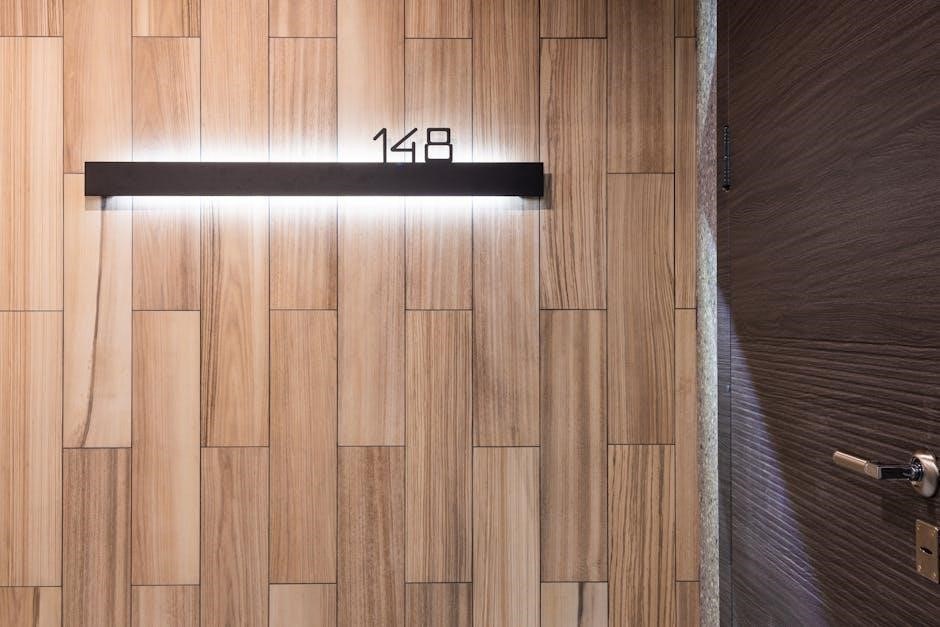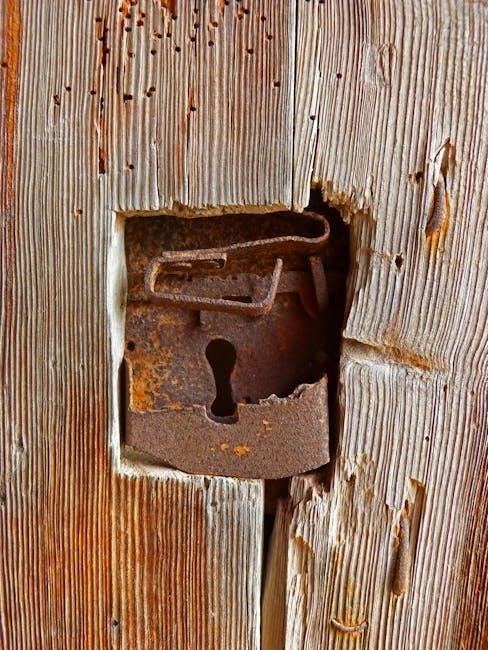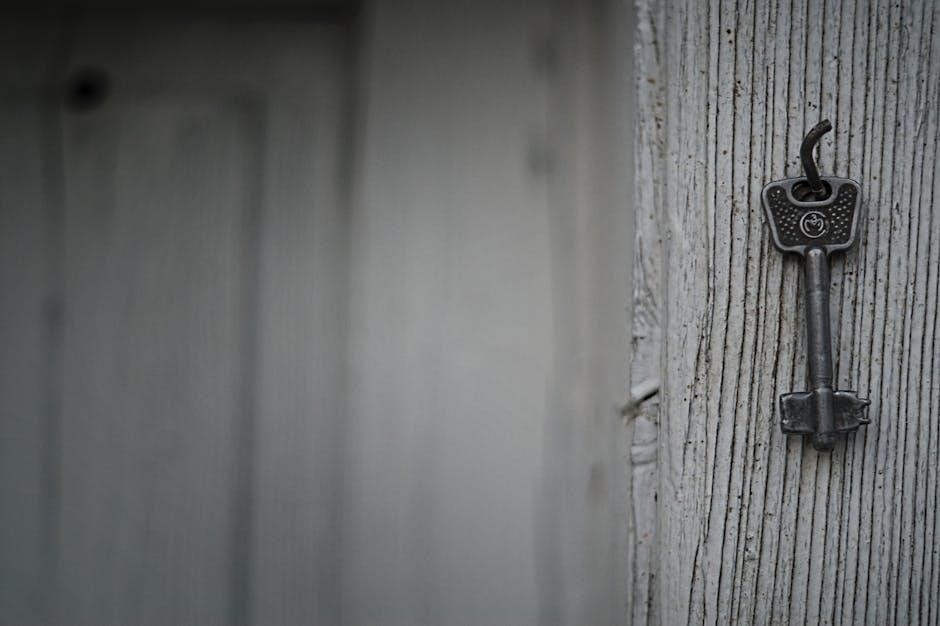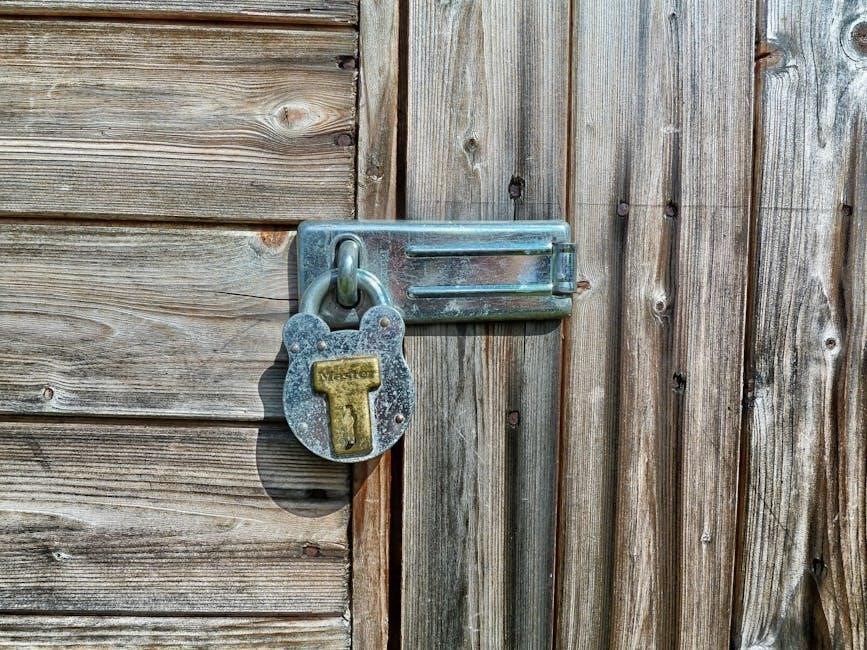
Magnetic door locks are electromagnets that secure doors by attracting an armature plate. They are widely used for their reliability and ease of installation. Wiring diagrams are essential for proper setup and troubleshooting, ensuring safe and efficient operation. These locks are popular in both commercial and residential settings due to their durability and versatility.
1.1 What Are Magnetic Door Locks?
Magnetic door locks are electromagnetic devices that secure doors by attracting an armature plate. They consist of an electromagnet and a steel plate that lock together when energized. These locks are highly reliable, offering strong holding forces and quick operation. They are commonly used in commercial and residential settings due to their durability and ease of installation. The lock engages when power is applied, creating a magnetic bond between the electromagnet and the armature plate, ensuring the door remains closed until de-energized.
1.2 Importance of Wiring Diagrams for Magnetic Door Locks
Wiring diagrams are crucial for the proper installation and functionality of magnetic door locks. They provide a clear visual representation of how components like the electromagnet, sensors, and power supply connect. This ensures safe installation, preventing electrical hazards and ensuring reliable operation. Diagrams also aid in troubleshooting, helping identify faulty connections or components. Compliance with safety standards, such as fire codes, is simplified with accurate wiring plans. Proper wiring enhances security, durability, and ease of maintenance, making diagrams indispensable for installers and technicians.

Understanding the Wiring Diagram
A wiring diagram provides a visual guide for installing and troubleshooting magnetic door locks. It outlines connections between components, ensuring proper setup and functionality while adhering to safety standards.
2.1 Components of a Magnetic Door Lock Wiring Diagram
A magnetic door lock wiring diagram includes key components such as the electromagnet, armature plate, power supply, sensors, and control units. It also shows wiring connections, fuses, and relays. The diagram illustrates how these elements interact to ensure secure locking and unlocking mechanisms. Proper understanding of these components is crucial for installation and troubleshooting, ensuring the lock operates safely and efficiently. Each part is labeled clearly, making it easier to identify and connect them correctly during setup.
2.2 How to Read a Magnetic Door Lock Wiring Diagram
To read a magnetic door lock wiring diagram, start by identifying the symbols and labels, which represent components like electromagnets, sensors, and power supplies. Trace the wires to understand connections between the lock, control units, and power sources. Pay attention to color coding, which indicates live, neutral, and ground wires. Check for fuses, relays, and connectors, ensuring all pathways are correctly routed. Verify the proper integration of sensors and monitoring systems. Follow the diagram step-by-step to connect components accurately, ensuring safe and functional installation. Always refer to the manufacturer’s instructions for specific guidance.

Key Components of Magnetic Door Locks
Magnetic door locks consist of an electromagnet, armature plate, sensors, and power supply. These components work together to ensure secure, efficient, and reliable door locking mechanisms in various settings.
3.1 Electromagnet and Armature Plate
The electromagnet is the core component of a magnetic door lock, generating a magnetic field to attract the armature plate. Made of steel or stainless steel, the armature plate is securely mounted on the door. When the electromagnet is energized, it creates a strong magnetic force, ensuring the door remains locked. Proper alignment and secure mounting of both components are crucial for optimal performance and safety. The electromagnet and armature plate work together to provide a reliable locking mechanism, essential for secure door operation in various settings.
3.2 Sensors and Monitoring Systems
Sensors and monitoring systems are critical for ensuring the proper functioning of magnetic door locks. Door status sensors detect whether the door is closed or open, ensuring the lock engages only when the door is fully shut. Monitoring systems provide real-time feedback, alerting users to issues like unauthorized access or system malfunctions. These components integrate seamlessly with access control systems, enhancing security and reliability; Advanced sensors may also detect tampering or forced entry, offering an additional layer of protection for secure environments.
3.3 Power Supply and Control Units
The power supply is a crucial component, providing the necessary voltage (typically 12V or 24V DC) to activate the magnetic lock. Control units regulate power delivery, ensuring the lock engages and disengages properly. These units often include features like voltage stabilization to prevent malfunctions. Advanced control units may integrate with access control systems, offering programmable settings for enhanced security. Proper installation and wiring of the power supply and control units are essential for reliable operation and to prevent overheating or electrical issues.

Types of Magnetic Door Locks
Magnetic door locks are available in single-door, double-door, and fail-safe or fail-secure configurations. These types are detailed in wiring diagrams for proper installation and functionality.
4.1 Single-Door Magnetic Locks
Single-door magnetic locks are designed for standard door sizes and provide reliable security. They consist of an electromagnet and an armature plate, with wiring diagrams detailing connections for power supply, sensors, and control units. These locks are ideal for residential use, offering ease of installation and operation. The wiring setup ensures proper functionality, with clear instructions in diagrams to prevent misconnections. Single-door locks are versatile and suitable for most entry points, requiring minimal space and offering durable performance.
4.2 Double-Door Magnetic Locks
Double-door magnetic locks are designed for wide or double doors, ensuring both doors are securely locked. These systems use two electromagnets and armature plates, with wiring diagrams guiding their proper installation. They are commonly used in commercial settings where higher security is needed. The wiring setup requires precise connections to synchronize both locks, ensuring simultaneous operation. Double-door locks offer enhanced security and are ideal for large entryways, with diagrams providing clear installation and troubleshooting guidance for seamless functionality.
4.3 Fail-Safe vs. Fail-Secure Magnetic Locks
Fail-safe magnetic locks release when power fails, ensuring emergency access. Ideal for fire exits, they prioritize safety. Fail-secure locks remain locked without power, enhancing security. Wiring diagrams help configure these modes, crucial for compliance with safety standards. Understanding these differences ensures proper installation for specific needs, balancing security and safety effectively in various applications.
Installation Requirements
Proper door and frame preparation is crucial for secure mounting. Ensure the armature plate aligns precisely with the electromagnet. Conceal wiring within the door frame for safety and aesthetics.
5.1 Preparing the Door and Frame
Proper preparation of the door and frame is essential for secure installation. Ensure the door and frame are aligned correctly and free from obstructions. Clean the surfaces thoroughly to remove dirt or grease. Verify the door closes evenly and the frame is sturdy enough to support the lock. Mark the armature plate’s position on the door frame, ensuring it aligns with the electromagnet. Drill pilot holes if necessary and anchor the frame securely to prevent misalignment. This step ensures a stable foundation for the magnetic lock system.
5.2 Mounting the Electromagnet and Armature Plate
Mount the electromagnet on the door frame and the armature plate on the door itself. Ensure the surfaces are clean and dry for optimal contact. Use screws to secure the electromagnet, making sure it is level and aligned with the armature plate. Avoid over-tightening to prevent damage. Verify the polarity of the wiring connections to ensure proper operation. Test the lock by applying power and checking the magnetic attraction. Proper alignment and secure mounting are critical for reliable functionality and long-term durability of the magnetic door lock system.
5.3 Concealing the Wiring for Safety and Aesthetics
Concealing the wiring enhances both safety and appearance. Route wires through the door frame or wall to avoid tampering or damage. Use cable management tools like raceways or conduits to protect and hide the wires. Ensure all connections are secure and follow local electrical codes. Regularly inspect the wiring for wear or damage. Proper concealment prevents unauthorized access and maintains a clean, professional installation, ensuring the magnetic door lock operates efficiently and safely for years to come while blending seamlessly with the surroundings.

Safety Considerations
Safety is crucial for magnetic door locks. Emergency release mechanisms ensure quick exits during power failures. Compliance with fire safety standards is mandatory for reliable operation.
6.1 Emergency Release Mechanisms
Emergency release mechanisms are vital for magnetic door locks to ensure safe evacuation during power failures or system malfunctions. These mechanisms, often manual overrides, allow doors to open without electricity. Key considerations include easy accessibility, clear labeling, and compliance with fire safety regulations. Regular testing ensures reliability. A backup power source, like a battery, can maintain functionality. Proper installation and maintenance prevent accidents, guaranteeing quick exits in emergencies. Always follow manufacturer guidelines for installation and testing to ensure optimal performance and safety compliance.
6.2 Fire Safety Compliance
Fire safety compliance is crucial for magnetic door locks, ensuring they meet local regulations for emergency exits. Locks must allow free exit during fires, often requiring fail-safe mechanisms. Wiring diagrams should outline connections for fire alarms to release locks automatically. Regular inspections and certifications ensure adherence to standards. Proper installation prevents obstructions, while clear signage guides occupants. Compliance ensures safety and legal adherence, avoiding potential hazards during evacuations. Always verify lock systems meet fire codes for reliable operation in emergencies.

Wiring the Magnetic Door Lock
Proper wiring ensures reliable operation of magnetic door locks. Connect the power supply, sensors, and monitoring systems according to the wiring diagram. Ensure all connections are secure and insulated for safety and longevity.
7.1 Connecting the Power Supply
Connecting the power supply is the first step in wiring a magnetic door lock. Refer to the wiring diagram to identify the correct terminals for the live and neutral wires. Ensure the power supply matches the lock’s voltage and current requirements. Connect the wires securely to avoid loose connections. Install a fuse or circuit breaker to protect against overcurrent. Double-check the connections for polarity and insulation. Test the power supply with a multimeter before integrating it with the lock. Always follow safety guidelines to prevent electrical hazards. Consult a professional if unsure about any step.
7.2 Integrating Sensors and Monitoring Systems
Integrate sensors like door position detectors and motion sensors into your magnetic door lock system for enhanced functionality. Use the wiring diagram to identify the correct terminals for sensor connections. Ensure sensors are aligned and calibrated for accurate detection. Connect monitoring systems to track door status and receive alerts. Secure all wires to prevent tampering. Test sensors and systems together to ensure seamless operation. Regularly update software for optimal performance; Always follow manufacturer guidelines for integration. This setup improves security and convenience, making it ideal for advanced access control. Proper integration ensures reliable monitoring and efficient door management.
7.3 Testing the Wiring for Proper Functionality
After wiring your magnetic door lock, test the system thoroughly to ensure proper functionality. Verify that the power supply is connected correctly and that all sensors align. Use a multimeter to check voltage and continuity. Test the lock’s activation and release mechanisms. Ensure the door status is accurately reflected by monitoring systems. Check for any short circuits or loose connections. Test the emergency release function to confirm it works as intended. Repeat the process under different conditions to simulate real-world use. Proper testing ensures reliable performance and safety, preventing future malfunctions.

Common Issues and Troubleshooting
Common issues include faulty wiring connections, power supply malfunctions, and sensor misalignment. Check connections, test sensor alignment, and ensure proper power supply to resolve these problems efficiently.
8.1 Identifying Faulty Wiring Connections
Faulty wiring connections are a common issue in magnetic door locks. To identify them, inspect the wiring diagram for loose or corroded wires. Use a multimeter to check for continuity and voltage drops. Ensure all connections are secure and free from damage. If a wire is pinched or frayed, replace it immediately. Faulty connections can cause intermittent lock operation or complete system failure, so addressing them promptly is crucial for maintaining security and functionality. Always refer to the wiring diagram for precise troubleshooting guidance.
8.2 Resolving Power Supply Problems
Power supply issues are critical for magnetic door locks. Check the wiring diagram to ensure the correct voltage is supplied. Use a multimeter to verify power at the lock and control unit. If voltage is low, inspect the power source and wiring for damage. Ensure all connections are secure and free from corrosion. If issues persist, verify the circuit breaker or fuse. Always refer to the manufacturer’s specifications for the recommended voltage. A stable power supply is essential for reliable operation, so address any irregularities promptly to prevent lock malfunction.
8.3 Fixing Sensor Misalignment Issues
Sensor misalignment is a common issue in magnetic door locks. To resolve this, ensure the sensor and magnet are properly aligned. Use a spirit level to check positioning. Adjust the sensor or magnet as needed, ensuring they are flush and parallel. Verify wiring connections for secure placement. Test the lock by opening and closing the door to confirm proper alignment. If misalignment persists, consult the wiring diagram for guidance or replace faulty sensors. Proper alignment ensures smooth operation and prevents malfunctions.

Advanced Features of Magnetic Door Locks
Advanced magnetic door locks offer features like access control integration, remote monitoring, and smart technology. These locks can be controlled via smartphones and provide real-time notifications for enhanced security.
9.1 Access Control Integration
Access control integration allows magnetic door locks to be connected with systems like keycards or biometric scanners. This enhances security by enabling user-specific access and real-time monitoring. The wiring diagram must include connections for readers and control units. Proper integration ensures seamless operation with existing security systems. This feature is ideal for commercial settings, providing audit trails and centralized management. It also supports multi-door systems, making it scalable for large facilities. Always refer to the wiring diagram for compatibility and installation guidelines.
9.2 Remote Monitoring and Smart Technology
Remote monitoring and smart technology enable users to control magnetic door locks via smartphones or computers. This feature provides real-time notifications and allows remote unlocking. The wiring diagram must include connections for Wi-Fi or Bluetooth modules. Smart integration enhances security by enabling scheduled access and monitoring door status. Compatible systems can also track usage history and battery levels. This technology is ideal for modern homes and businesses, offering convenience and advanced security features. Always ensure compatibility with your lock system for seamless operation.

Case Studies and Examples
Case studies showcase magnetic door lock installations in residential and commercial settings, highlighting their versatility and efficiency in providing secure access solutions.
10.1 Residential Magnetic Door Lock Installation
Residential magnetic door locks are popular for their ease of installation and silent operation. Homeowners often install them on front doors or interior rooms for added security. The wiring diagram ensures proper connections between the lock, sensors, and power supply. Concealing wires within the door frame enhances safety and aesthetics; Proper alignment of the electromagnet and armature plate is crucial for reliable functionality. Many residents integrate these locks with smart home systems for remote monitoring. Magnetic locks provide a modern, low-maintenance solution for residential security needs, offering peace of mind and convenience.
10.2 Commercial Magnetic Door Lock Setup
Commercial magnetic door locks are ideal for high-traffic areas like offices, schools, and hospitals. They offer robust security and durability, withstanding frequent use. The wiring diagram simplifies installation, ensuring correct connections for fail-safe or fail-secure operations. These locks are often integrated with access control systems, card readers, and alarms for enhanced security. Proper installation requires precise alignment of the electromagnet and armature plate. Commercial setups may include additional features like emergency release mechanisms and fire safety compliance, making them a reliable choice for securing premises with high security demands and operational efficiency.

Best Practices for Maintenance
Regularly inspect wiring and components for wear or damage. Clean and lubricate moving parts to ensure smooth operation. Check electrical connections for security and integrity to maintain reliability and safety.
11.1 Regular Inspection of Wiring and Components
Regular inspection of wiring and components is crucial for maintaining the functionality of magnetic door locks. Check for signs of wear, damage, or corrosion on wires and connections. Ensure all components, such as the electromagnet and armature plate, are securely fastened. Verify that the wiring diagram aligns with the actual setup to prevent mismatches. Use a multimeter to test electrical continuity and voltage levels. Consult the user manual for specific inspection guidelines tailored to your lock model. Address any issues promptly to avoid system failures and ensure reliable performance.
- Inspect wiring for frays or cuts.
- Check electrical connections for tightness.
- Ensure components are free from dust and debris.
11.2 Cleaning and Lubricating Moving Parts
Cleaning and lubricating moving parts of magnetic door locks is essential for optimal performance. Use a soft brush or cloth to remove dust and debris from the armature plate and hinges. Apply a silicone-based lubricant to pivoting points to reduce friction and wear. Avoid over-lubrication to prevent dust accumulation. Refer to the wiring diagram to ensure proper maintenance without damaging electrical components. Regularly inspect and clean to extend the lock’s lifespan and ensure smooth operation. Lubricate sparingly and test functionality after maintenance.
Magnetic door locks offer reliable security solutions. Proper wiring and maintenance ensure optimal performance. Always follow diagrams and guidelines for safe, efficient installation and troubleshooting.
12.1 Summary of Key Points
Magnetic door locks provide reliable security through electromagnetic attraction. Correct wiring, as shown in diagrams, ensures smooth operation. Key components include electromagnets, sensors, and power units. Installation requires precise mounting and concealed wiring for safety. Regular maintenance, such as inspecting connections and cleaning parts, prolongs functionality. Understanding wiring diagrams is crucial for troubleshooting issues like faulty connections or sensor misalignment. Following safety guidelines ensures emergency releases and fire compliance. Proper setup enhances performance and security, making magnetic locks a versatile choice for various applications.
12.2 Final Tips for Safe and Effective Use
Always follow the wiring diagram and manufacturer’s instructions for installation. Regularly inspect wiring and components to prevent wear and tear. Ensure emergency release mechanisms are functional for safe exits. Adhere to fire safety standards and local regulations. Mount locks securely to prevent tampering; Test the lock after installation to confirm proper operation. Keep the armature plate aligned with the electromagnet for reliable performance. Store the wiring diagram for future reference or troubleshooting. By following these guidelines, you can ensure a secure, efficient, and long-lasting magnetic door lock system.